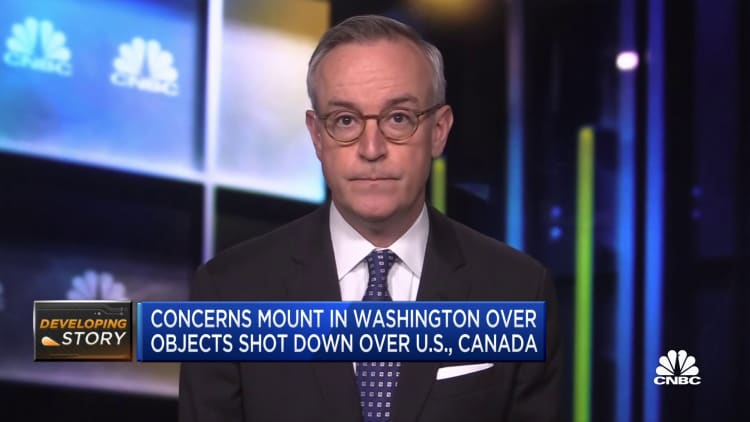White House defends shooting down three aerial objects, despite not knowing who launched them or why
The White House on Monday said it doesn't yet know what the aerial objects are that were shot down this weekend, who owns them or their purpose.

Coordinator for Strategic Communications at the National Security Council John Kirby speaks during the daily press briefing at the White House February 13, 2023 in Washington, DC.
Drew Angerer | Getty Images News | Getty Images
WASHINGTON — The White House on Monday defended President Joe Biden's decision to shoot down three low-flying, aerial objects over U.S. and Canadian airspace in the past three days, but said it had not determined yet exactly what the objects were, who owned them or their purpose.
"We have not yet been able to definitively assess what these most recent objects are," John Kirby, a spokesman for the National Security Council, said at a White House briefing.
"And while we have no specific reason to suspect that they were conducting surveillance of any kind, we couldn't rule that out," Kirby added.
Each of the three crafts was the size of a small car and was floating on prevailing winds.
The first of the three crafts was destroyed on Friday in U.S. airspace over Alaskan waters. It was cylindrical and had been floating at around 40,000 feet in altitude, Kirby said, posing a threat to civilian aircraft.
On Saturday, the U.S. and Canada coordinated the use of American military jets to shoot down a second object, this time overland in the remote Canadian Yukon.
That craft was similar in size, shape and flight altitude to the one that was shot down on Friday, Kirby said.
CNBC Politics
Read more of CNBC's politics coverage:
Nikki Haley enters race for president as first challenger to Trump for the Republican nominationWhite House defends shooting down three aerial objects, despite not knowing who launched them or whyParts of Georgia grand jury report on election meddling to be released this weekU.S. sanctions six Chinese tech companies for supporting spy balloon programsDemocrat and Republican attorneys general square off over lawsuit seeking to pull abortion pill from U.S.U.S. shoots down second 'high altitude object' days after downing Chinese spy balloonFBI finds another classified document in search of Mike Pence's home, his spokesman saysNational Archives sued for telling visitors to remove 'pro-life' clothingSEC weighs making 'adjustments' to controversial climate risk disclosure rule, Chairman Gensler saysAngry senators grill Pentagon officials over Chinese spy balloon responseU.S. may target Chinese entities linked to spy balloonFBI investigating Chinese spy balloon, but much of the evidence is still under waterDemocratic Rep. Angie Craig assaulted in apartment building elevator, her office saysGOP voters pick DeSantis over Trump in hypothetical head-to-head matchup for 2024 presidential nomination, new poll showsBiden's billionaire tax is 'dead on arrival' in Congress, top Wall Street backers and Democratic strategists sayChinese spy balloon carried ‘multiple antennas’ for collecting signals intelligence, State Dept. saysWatch live: Senate holds first hearing on the suspected Chinese spy balloonWatch live: Senate Foreign Affairs Committee holds a hearing on U.S.-China policy and competitionBiden proposal to cap all insulin prices at $35 a month has little chance of passing CongressBiden's State of the Union may not help potential 2024 election bid against Trump, experts sayU.S. explores working with India to increase economic competition against China, says Commerce Secretary Gina RaimondoSpy balloon confirms 'pattern of Chinese behavior' that poses threat to NATO members, Stoltenberg saysThe third object was octagonal and was flying lower, at approximately 20,000 feet. That object was shot down Sunday over Lake Huron on the U.S.-Canadian border.
Kirby said the sharp increase in the number of objects shot down in recent days was partly a result of heightened radar sensitivity implemented in the wake of the discovery of a massive Chinese spy balloon in late January.

That balloon was 200 feet high and carried a payload of surveillance equipment. Defense officials opted to let it float over the continental U.S. for a week before shooting it down Feb. 4 above the waters off South Carolina.
"One of the reasons we're seeing more [aerial objects], is because we're looking for more," Kirby said Monday, taking pains not to call the three latest objects "balloons."
"We need to separate [the three recent objects] from the Chinese spy balloon," he said. In the spy balloon situation, "we knew what it was, we knew where it was going, we knew what it was doing." This time around, there are more questions, he said.
"We know that [Chinese] surveillance balloons have crossed over dozens of countries on multiple continents around the world, including some of our closest allies and partners," said Kirby.
"We also know that a range of entities, including countries, companies, research and academic organizations operate objects at these altitudes for purposes that are not nefarious at all, including scientific research," he said.
The effort to salvage debris from the latest incidents has been hindered so far by remote terrain and freezing temperatures, both on land and in the deep waters of Lake Huron and the Arctic Ocean.
On Monday, Secretary of Defense Lloyd Austin said that American and Canadian teams had "not recovered any debris" following the three shootdowns over the weekend. "We don't know if they were actually collecting intelligence," he told reporters shortly after landing in Brussels.
In addition to the more immediate recovery and forensic investigations of the objects themselves, the Biden administration took steps Monday to address the broader implications of these objects for U.S. defense and foreign policy.
A new interagency task force has been assembled in order to study the broader ramifications of "detection, analysis and disposition of unidentified aerial objects that pose either safety or security risks," Kirby told reporters at the White House.
The Chinese government has denied any involvement with the three most recent floating objects.
And while Beijing admitted that the surveillance balloon shot down Feb. 4 was indeed Chinese, it insisted the high-tech aircraft was merely an errant weather balloon blown off course.
High-altitude weather balloons have a maximum diameter of approximately 20 feet, according to the National Weather Service. The Chinese surveillance balloon was around 10 times that size, according to a Defense Department official.

 Troov
Troov 































